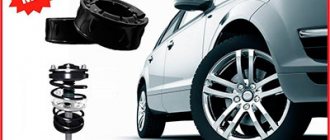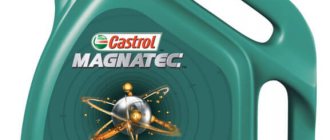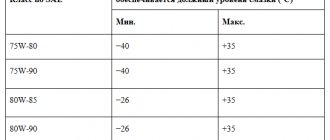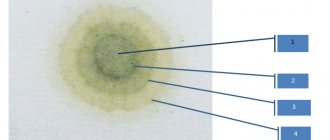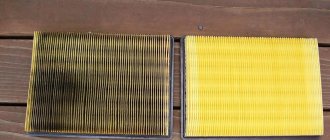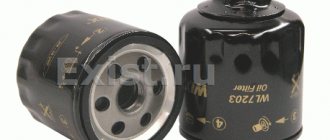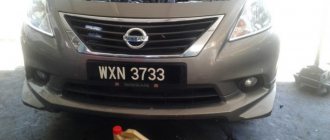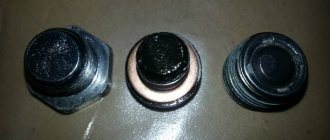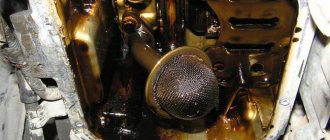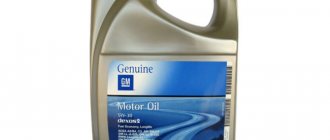- home
- Brands
- Honda
21.07.2020
The Honda CR-V model appeared in 1995, the very beginning of the crossover fashion trend, which largely explains the success of the car, which is still produced to this day. Five generations of the so-called “SUV” have absorbed the best qualities: the economy of cars and the cross-country ability of jeeps. A spacious interior, original body design, all-wheel drive and a fairly powerful engine, combined with good handling, ensured increased demand, especially in the first generations.
https://www.youtube.com/watch?v=XJUsbnzRYO8
- 4.1 Other articles:
Honda CR-V II 2002-2006, gasoline
It is recommended to use oils that reduce fuel consumption, corresponding to API groups SJ or SL
Scheme 1. Selection of viscosity depending on the temperature range outside the car.
According to the diagram, you need to use the following lubricants:
- 0W-20;0W-30; 0W-40; 5W-20; 5W-30; 5W-40, in the temperature range from -300С (or less) to + 400С (or more);
- 10W-30; 10W-40 at temperatures -200C to + 400C (and above).
- 15W-40 at temperatures from -150C to + 400C (and above).
Filter selection
To change the oil, you need to choose a high-quality filter that can filter out contaminants from the engine fluid. According to official regulations, the use of Honda brand filter devices is recommended. In their absence, the use of oil filters from Bosch, VIK, Sakura, PIAA, Japanparts, Kamoka, AMC, Starline, Clean Filters, Profit, etc. is allowed.
According to user reviews, original filters and Bosch products are considered the best options.
Honda CR-V III 2007 – 2012 model years
Based on the Honda CRV operating instructions, for this car model it is recommended to use lubricants that meet the specifications below.
Cars equipped with gasoline engines.
The car manufacturer strongly recommends that throughout the entire period of operation of the car, pour original Honda Motor Oil that meets the requirements:
- Cars supplied to Europe:
- according to the ACEA system - oil types A1/B1, A3/B3 or A5/B5.
The use of such motor oils helps to save the fuel mixture. To select lubricant for Honda CRV, use diagram 1.
Scheme 2. Dependence of the oil viscosity of gasoline cars (supplied to Europe) on the temperature indicators of the region in which the vehicle is operated.
According to this scheme it is necessary to pour:
- 0W-20, 0W-30; 5W-30 at a temperature range from -300С (or less) to + 400С (or more);
- 5W-30 at temperature conditions from -200С to + 400С (and above).
Using 0W-20 lubricant reduces fuel consumption.
- Machines not supplied to Europe.
According to the manual, to ensure the performance and durability of the engine, it is recommended to fill with original Honda Motor Oil engine fluids that have the following parameters:
- according to the API standard - oil classes SL or higher.
Based on viscosity indicators, the motor oil is selected according to Scheme 2.
Diagram 3. Dependence of engine oil thickness for gasoline engines (not supplied to Europe) on the temperature outside the car.
According to scheme 2, the following lubricants are used:
- 0W-30; 0W-40; 5W-30; 5W-40, if the air temperature is from -300С (or less) to + 400С (or more);
- 10W-30; 10W-40 at a temperature range of -200C to + 400C (and above).
- 15W-40 at temperatures from -150C to + 400C (and above).
* - for vehicles equipped with an engine oil level sensor, the specified oil is not used.
Filling with 0W-30 liquid helps to save the combustible mixture.
Diesel cars
The Honda Srv manufacturer recommends pouring motor oils with the following parameters:
- original Honda Motor Oil motor lubricants;
- in accordance with the ACEA classification system - C2 or C3.
The viscosity characteristics of the motor oil are selected according to scheme 3.
Scheme 4. Dependence of the fluidity of motor oil for diesel engines on the temperature outside the car.
The decoding of scheme 3 is similar to scheme 2.
Using 0W-30 motor fluid makes it possible to reduce fuel consumption.
Consistencies of our own development: Honda Z1 and DW1 as ATF (Automatic Transmission Fluid)
Owners of the first CR-Vs probably know about the proprietary fluid for the famous “automatic machines”. Owners of the very popular third series of crossover have also heard about the “native” ATF Z1 oil.
Then some owners were surprised by the fact that when using synthetic motor oil for the Honda SRV automatic transmission, mineral Z1 was still required , the production recipe for which was developed back in 1995. Owners of new products, the production of which was launched after 2011, are notified that synthetics, labeled DW1, are already splashing in the crankcase and torque converter of the “automatic”.
Changing the oil type entailed:
- decrease in viscosity at low temperatures;
- increasing the stability of the lubrication process under various conditions;
- reduction in fuel consumption.
Owners of previous generations of Honda CR-V: ATF Z1 will no longer be produced, but I was assured that DW1 is fully suitable for partial replacement, that is, it “supports” mixing with Z1. Some owners of the third generation CR-V went further: they dismantled the automatic transmission and completely switched to DW1 synthetic oil. Here's what one of them wrote:
“The automatic transmission also operates smoothly, but the car itself has become more rolling.”
The situation is quite predictable - after all, the iron component did not undergo changes during regeneration: the same five-speed automatic Honda CRV was first filled with ATF Z1 mineral water, and in the fourth generation - DW1 synthetics. With earlier generations, problems arise: the torque converter begins to operate in an extremely rough mode.
2013 Honda CR-V IV
Gasoline power units
According to the manual, it is necessary to use motor oils that have the following characteristics:
- Machines supplied to Europe
- according to ACEA classification - A3/B3, A5/B5;
- according to SAE 0W-20 classification.
0W-20 motor oil makes it possible to achieve a reduction in fuel consumption.
- Vehicles not supplied to Europe:
- original Honda Motor Oil lubricants;
- according to API classification - SM or higher.
- viscosity parameters of liquids are selected according to scheme 4.
Scheme 5. Viscosity of motor oils depending on temperature conditions.
According to the diagram, you need to pour lubricants:
- 0W-30; 0W-40; 5W-30; 5W-40, with a temperature range from -300С (or less) to + 400С (or more);
- 10W-30; 10W-40 if the air temperature is from -200C to + 400C (and higher).
- 15W-40 at temperature conditions from -150C to + 400C (and above).
5W-30 engine fluid reduces fuel consumption.
Diesel cars
According to the manual, motor lubricants are used:
- Cars supplied to Europe
- Honda branded fluids;
- according to ACEA requirements - C2 or C3.
- according to SAE 0W-30 (helps reduce fuel consumption), if the specified motor oil is not available, fill in 5W-30.
- Vehicles not supplied to Europe
Recommended engine oil for Honda CR-V with parameters similar to diagram 3.
Parameters of motor fluids
The technical characteristics of Honda Ultra Ltd 5W30 SM, Honda Ultra Ltd 5W30 SN, Mobil 1 5W30 oils are as follows:
| Index | Meaning | ||
| Oil name | Honda Ultra Ltd 5W30 SM | Honda Ultra Ltd 5W30SN | Mobil 1 5W30 |
| Density at 15°C, kg/m³ | 861 | 858 | 855 |
| Viscosity index | 162 | 158 | 165 |
| Kinematic viscosity, mm/s²: at 40/100°C | 57/13,1 | 54/12,3 | 61/12,8 |
| Solidification of the substance, °C | -40 | -35 | -42 |
| Ash residue, % | 1,12 | 0,92 | 1,34 |
| Alkalinity, mg KOH per 1 g of oil | 10,4 | 9,6 | 11,2 |
| Spontaneous combustion, °C | 247 | 250 | 238 |
| Volatility, % | 11,4 | 11,1 | 12,3 |
The products are available in 1 liter plastic bottles and 4 liter canisters. In addition, you can find metal cans with a capacity of 4 liters.
Honda CR-V IV 2.4 2015 release
Machines supplied to Russia, Ukraine, Kazakhstan, Belarus
The requirements for motor oil are as follows:
- according to the ACEA standard - A1/B1, A3/B3, A5/B5;
- according to SAE 0W-20 standards, if such a liquid is not available, use 0W-30 or 5W-30.
In addition to machines supplied to Russia, Ukraine, Kazakhstan and Belarus
The Honda SRV manufacturer's recommendations regarding motor oil are as follows:
- Honda branded fluids;
- in accordance with API classification - SM or higher.
- viscosity is selected according to scheme 5.
Scheme 6. Dependence of the viscosity characteristics of lubricating fluids on ambient temperature.
According to the scheme, motor oils are used:
- 0W-20;0W-30; 0W-40; 5W-30; 5W-40, in the temperature range from -300С (or less) to + 400С (or more);
- 10W-30; 10W-40 at temperatures -200C to + 400C (and above).
- 15W-40 at temperatures from -150C to + 400C (and above).
To save fuel mixture, it is recommended to use 0W-20 lubricant. When selecting motor oil for cars supplied to Europe, only the ACEA system is used.
A few words about the timing of oil changes in automatic transmission and engine
The manufacturer's recommended replacement interval is 15-20 thousand km. - conditional . The domestic environment (the condition of the roads, the culture of movement in the metropolis...), in which most cars are operated, is perceived by Japanese experts as extremely stressful for the operation of the life-supporting units of the car.
In such conditions, to reduce change intervals for any Honda SRV as follows:
- 0W-20 – every 7,500 km;
- all other brands - every 5,000 km.
The trend also applies to the "automatic":
- first shift – after 80,000 km;
- subsequent ones - after 60,000 km.
Replacement intervals
For Honda SRV RD1 1997, 1998, 1999, 2002, 2004, 2008, 2010, 2011, 2012, 2013, 2014 and other model years, the manufacturer advises changing the lubricant at least after 15 thousand kilometers. This rule for replacing fluid in cars running on gasoline or diesel is relevant when operating the vehicle under ideal conditions. If the car is used in a big city and often operates in start-stop mode (in traffic jams) or on highly dusty roads, then the replacement frequency should be reduced to at least 10 thousand km. The optimal oil change interval is 7500-10000 km.
User Yuri Danger talked about how the lubricant is changed in a Honda SRV car.
The frequency of replacement may be lower if the following symptoms appear:
- The power unit began to operate louder than usual. If the rubbing parts are lubricated normally, then they will not make any extraneous sounds during operation. When using old oil that has lost its properties, the engine will run an order of magnitude louder, this is especially evident when it starts. If the fluid does not have its original characteristics, the internal combustion engine elements are subject to greater friction. When the lubricant level in the system decreases, the driver may hear sounds from metal parts. This indicates that the volume of liquid in the unit has decreased to critical. The car owner needs to urgently change the lubricant or add it to the system.
- The car enthusiast sees or feels exhaust gases. In terms of environmental friendliness, modern cars are significantly superior to older cars with worn-out engines. As a result of equipping power units with catalytic converters and improving design features, a properly functioning engine will not produce exhaust. When using high-quality lubricant, clear exhaust gases come out of the muffler. If smoke-like exhaust appears from the pipe, this may indicate the use of low-quality oil that has lost its properties. There should be no smell of burnt grease in the exhaust gases.
- The engine began to function unstably. Microparticles form in the used oil and clog the filter element. Therefore, the circulation of lubricant through the system is disrupted, as a result of which the power unit cannot operate at a constant speed. When you press the gas pedal, slight dips are felt at first.
- The appearance of an indicator in the form of an oil can on the dashboard of the car. The reason for the icon on the dashboard to light up can be different, but it is usually associated with a lack of engine fluid in the lubrication system.
Level control and required volume
To understand how much lubricant you need to pour into the engine, read the technical manual; it contains all the recommendations regarding its volume. About 4 liters of liquid are poured into two-liter power units; about 5 liters of lubricant must be poured into 2.4-liter engines. To control the level, open the hood of the car and find the dipstick installed in the engine. Remove it and clean it with a rag from any remaining oil; level diagnostics are performed on a cold engine. Then put the dipstick back and remove it again. Ideally, the lubricant level should be between the two marks MIN and MAX. If there is more oil, it must be drained, if there is less, add it.
Photo gallery
Unscrew the bolt on the drain hole and drain the lubricant from the internal combustion engine
Remove the filter with a puller or by hand
Fill the system with new oil

